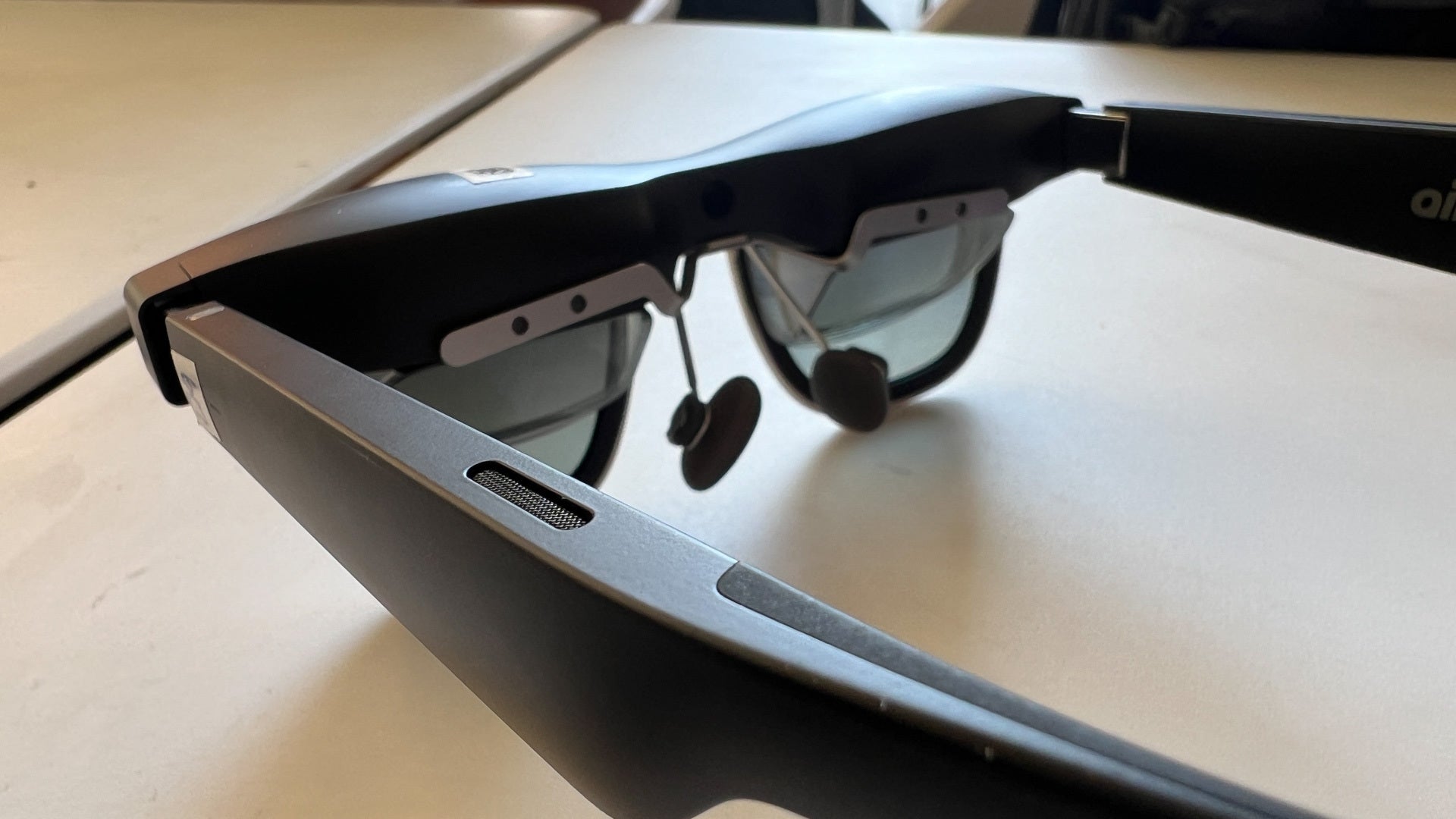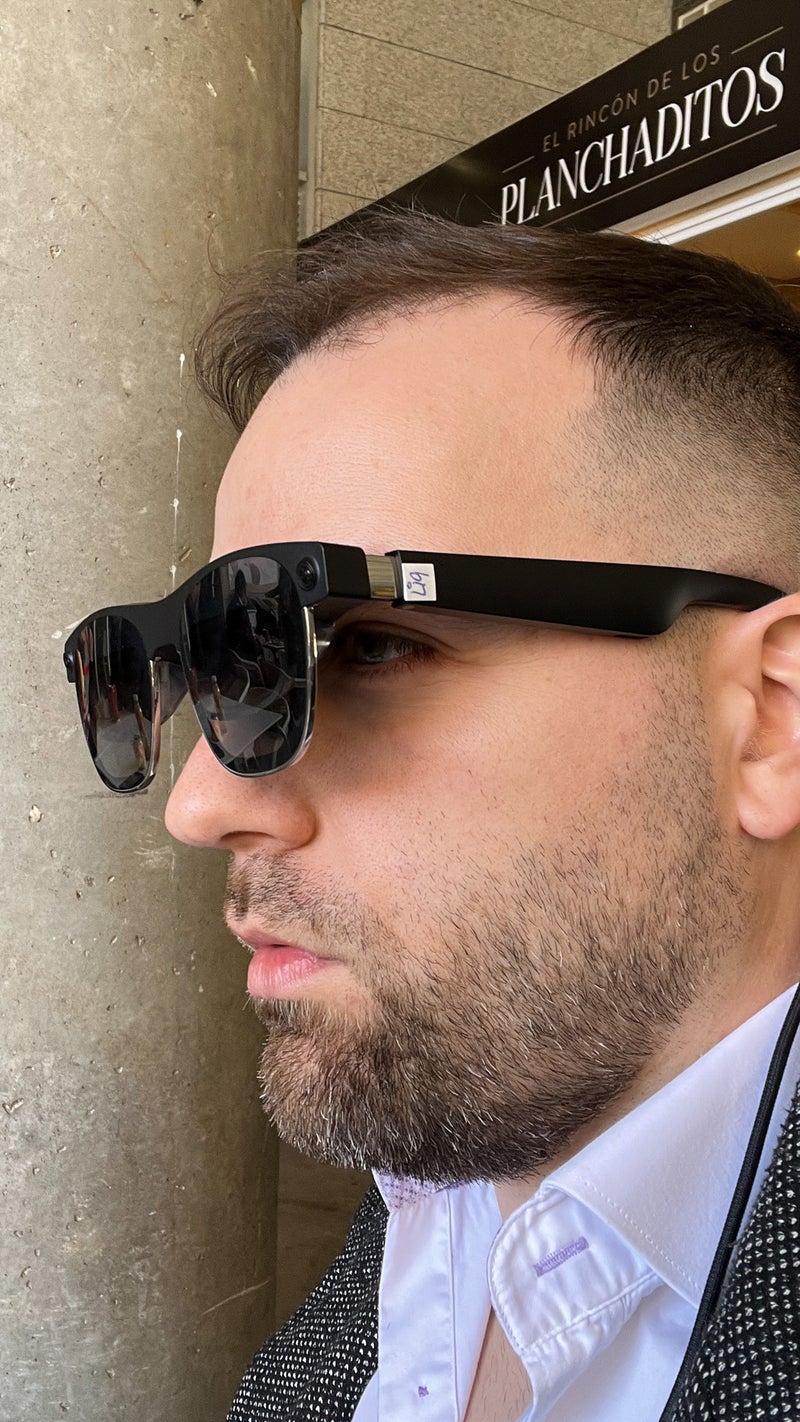Xreal Air 2 Ultra preview: next-level AR experience

After the somewhat lukewarm reception following the Apple Vision Pro launch, I got a bit hesitant about the future of AR for a moment. Now that I took the upcoming Xreal Air 2 Ultra glasses for a spin, though, I think AR is alive and well! It's getting better than ever, actually, and while we're certainly still very early in the AR journey, the Xreal Air 2 Ultra is shaping up to be a bold next step in the right direction.
The Xreal Air 2 Ultra is the upcoming top-of-the-line model in Xreal's Air line. It strongly resembles the already available Air 2 Pro, but adds actual AR / spatial computing capabilities thanks to a couple of sensors built into the glasses' end pieces.
These 3D environment sensors are not cameras, they can't capture footage of the world around you. They are what Xreal says they are: sensors designed to see and understand the environment around the user. It's what allows the Air 2 Ultra to "anchor" 3D objects in space and keep them there. See, previous Xreal Air glasses didn't offer much in the way of actual AR. They delivered a display mirroring experience that allowed you to project your phone's or computer's screen onto the glasses' built-in OLED displays, but they couldn't map out the 3D environment around you and let you have floating app windows in virtual 3D space.
Read more:
The Air 2 Ultra changes that. The demo I experienced at the Mobile World Congress featured different scenes and scenarios that showcased the glasses' AR capabilities. And let me tell you this: the Xreal Air 2 Ultra put up a convincing performance.
Next-gen, advanced AR glasses design

The Xreal Air 2 Ultra looks pretty convincing from the front (image credit - PhoneArena)
These aren't Xreal's first glasses, and this has allowed the company to learn from all the feedback it's managed to collect over the last couple of years.
The Air 2 Ultra feel light! They weight about 80 grams, which is ever so slightly heavier than the sensor-less Air 2 Pro, but these are still very similar in terms of shape, feel and weight to normal sunglasses. In contrast, Apple's Vision Pro, which is obviously a way more technologically sophisticated piece of hardware, is in the 600-650 grams range. That means the Air 2 Ultra are real spatial computing glasses that you can wear for a really long time without getting fatigued.

Flexible temples, soft nosepads, balanced (light) weight distribution – this is what advanced AR design is supposed to be (image credit - PhoneArena)
Not only are the Air 2 Ultra very light, though, which is partly thanks to their titanium frame. Xreal is using very impressive soft and flexible materials for the temples and the nose pads. These soft materials are even more sophisticated and convenient than those in your typical non-smart pair of glasses. These components are specifically designed to enable multi-hour usage without causing discomfort in the typical pressure points.
Still not a fashion icon
The biggest style drawback I can see is how further out on the face the Air 2 Ultra tends to sit.
Let's put it this way: if I need to choose between showing up in public wearing the Xreal Air 2 Ultra or the Apple Vision Pro, I'll choose the Air 2 Ultra every time.
Sadly, this is not to say Xreal's glasses are ready to elevate your style like a normal pair of sunglasses would. They are of a decently balanced size for a one-size-fits-all product, so they'd probably fit most people fine, but more so males than females. The biggest problem I see from appearance standpoint is that they tend to sit way further out on the face, and so there's a very significant gap between the glasses and your eyes, as you can see on the picture.
Because of that, they aren't quite perfect yet as a normal pair of sunglasses, and they definitely don't look very stylish when seen from the side. The front is a different story – they tend to successfully emulate a normal wayfarer type of look when seen from the front. Which is great! It means we're halfway there on the road to create the perfect AR glasses from design standpoint.

Xreal Air 2 Ultra (image credit - PhoneArena)
An important point here is the Air 2 Ultra comes with S/M/L sizes of nosepads in the box, and while I could try just one of the sizes (not sure which one), playing around with a different set of nosepads and making some adjustments to them might allow you to bring the Air 2 Ultra a bit closer to your face.
The AR experience
Now for the good stuff – the spatial computing aspect of the Air 2 Ultra.
In short, they work. One of the demos involved having an animated 3D model fixed in space in front of me, and I was able to walk around, move in and out, and look at it from different angles. It didn't seem to budge one bit. Which is good – that's all we want from a pair of AR glasses! The animated 3D model of a spaceship looked pretty good as well; it was a nicely detailed model that moved smoothly, which makes me hopeful about the Air 2 Ultra's hardware capabilities.

The Xreal Air 2 Ultra comes with 2 Micro OLED displays with 120 Hz refresh and 1920x1080 px resolution each (image credit - PhoneArena)
Another demo showcased the 3D mapping ability of the Air 2 Ultra, i.e. the thing that allows the glasses to scan the user's environment and have 3D objects interact with it. This one also worked pretty well. There were no unexpected hiccups or mishaps as I looked around and saw the glasses build out the 3D map of the surrounding world in real time. On top of that, the demo showcased AR's gaming potential, as it let me move a character around the 3D map the glasses had just constructed based on my environment. Pretty cool!
Another demo allowed me to interact with 3D objects using my own hands and doing a pinching gesture, akin to the Vision Pro. This one was far from flawless: while the glasses did a good job of smoothly displaying 3D avatars of my hands as I moved them around, the precision seemed to be somewhat lacking when it came to pinching 3D objects and moving them around. It worked, but it wasn't exactly seemless. Of course, it needs to be very clear that what I was testing was very incomplete software, so it's very possible that the experience with the final product may be significantly better.
The final demo revolved around watching video, which Xreal's glasses tend to be great at, and this one was wonderful. I could seemlessly switching between 3 different videos, all the while there were some 3D objects sitting around my FoV. The glasses played everything smoothly.

The image quality that you get from the dual 120Hz OLED displays of 1920x1080 px resolution each looked great. I'll need to test the product further, but my first impression is very positive. The blockbuster feature, which is also found on the Air 2 Pro, is called electrochromic dimming, and it allows you to switch between three levels of dimming with a push of a button. The first level is most conducive to AR, because it's just clear vision. But push the button situated on the right temple once, and the glasses dim the environment by 35%. This view gives you a great balance between still seeing the real world, but also making the virtual overlay more visible.
Another push of the button dims the glasses to 100%, which makes them really black (by the way the glasses themselves change color, which is pretty cool), and this mode allows for the best visibility of whatever you're viewing on the glasses. This will be the most immersive mode for media consumption use cases like watching movies.
The only thing that is perhaps a bit disappointing right now is the relatively narrow field of view of 52 degrees. This is slightly wider than the 46-degree FoV of the Air 2 and 2 Pro, but it's still pretty narrow, especially compared to full-on VR hardware like the Quest 3 or Vision Pro, which offer 100+ degree fields of view. Xreal notes that this limitation is currently imposed by the compact AR form-factor they're going with, and hey, if that's the price to pay for a normal-looking pair of augmented reality glasses, I'll take it.
Developers, developers, developers
The Xreal Air 2 Ultra will be available to order in late March or April, but Xreal is perfectly aware that their proper AR glasses don't have a lot to offer in the way of software experiences that could take advantage of spatial computing. This is why this late Q1 / early Q2 launch is specifically geared towards developers. Xreal hopes that it'll have accumulated enough spatial computing apps for a proper consumer launch in late summer or in the fall of this year.
Of course, all the other capabilities that we already have in glasses like the Air 2 Pro will be available. You'll still be able to mirror your phone's screen and enjoy a large and high-refresh-rate AR/VR image.
Xreal Air 2 Ultra price, release date and expectations

Xreal Air 2 Ultra will launch for consumers in late summer or in the fall of this year, at a price of $699 (image credit - PhoneArena)
The Xreal Air 2 Ultra are considerably more expensive than current Air models. For example, the original Air is currently on sale for around $300, the Air 2 is available for $399, and the Air 2 Pro costs $449. The spatial computing-capable Air 2 Ultra is priced at $699 – a very substantial increase over the Pro.
Will it be worth it? Depends on whether Xreal will be successful in partnering with developers to create a meaningful and useful AR / spatial computing system of apps. The hardware is good, but the software is clearly not there yet, which is why this will be Xreal's most critical objective right now. Get enough developers on board to build enough useful apps.
We're still in the very, very early days of the augmented reality story. In fact, I'm not sure the story has even begun yet! But from what I saw today while testing the Xreal Air 2 Ultra, I'm hopeful again that AR will be one of those rare next big things in tech. We're just not there yet, but give it some time, and it's going to make a huge, huge splash.
As for the Air 2 Ultra – it's just another step towards the grand AR vision. And what a step it is! Available for pre-order right now at $699, it'll go through a developer-focused launch phase in late March or April, with a planned consumer launch in late summer or sometime in the fall of 2024. We'll be there to meet it again.
Follow us on Google News


















Things that are NOT allowed:
To help keep our community safe and free from spam, we apply temporary limits to newly created accounts: